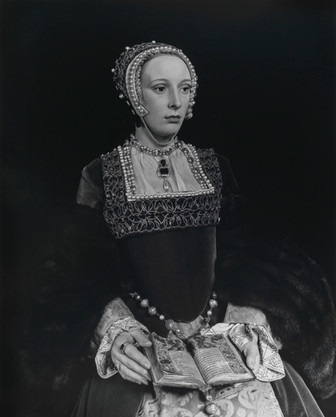'The Lives of Six Wives' at the National Portrait Gallery
★★★☆☆

Portrait miniature of Anne of Cleves, 1539, Hans Holbein the Younger.
Image, and all others in this article, provided courtesy of National Portrait Gallery.
SIX, a West End musical phenomenon, is the story of Catherine of Aragon, Anne Boleyn, Jane Seymour, Anne of Cleves, Catherine Howard, and Katheryn Parr—the six wives of Henry VIII. In the National Portrait Gallery’s latest exhibit, under the meticulous eye of head curator Charlotte Bolland, the musical has partnered with the gallery to present an encompassing display which aims to correct some of the misguided narratives surrounding these women.
Urban myths, cautionary tales, and political smear campaigns have metastasised the very real lives of these very real women into tales of fiction and folklore. This collection of miniatures, literature, letters, and portraits provides an insight into the families, upbringings, and personalities of these notorious queens while they were present in the Tudor royal court, and in the years preceding their arrival.
Naturally, with a topic as broad as the Tudors, this new exhibition is lacking in some areas. For example, it glances over the queen consorts' diplomatic roles in the Royal Court and, for a collection centred around the women, perhaps focuses too much on the men. There are huge portraits of Thomas Cromwell and Nicholas Carew, the man responsible for levying incest claims against Anne Boleyn and her eventual beheading. Their inclusion doesn’t take away from the collection but certainly doesn’t add to it, and the space could have been better utilised to widen the depth of the material being showcased. Although clearly an exhibition curated with care, interest, and passion, it did feel somewhat surface-level and brief in some areas.
Namely, the cinematography section had a whole room dedicated to it, and yet provided only an extremely brief outline of costumes designed by John and Ann Bloomfield for the 1970 BBC drama, ’The Six Wives of Henry VIII’. In a topic as rich and dense as the film world, the area felt like an afterthought or a filler. Perhaps a necessary inclusion due to the gallery’s partnership with the west-end musical, but needless against the wider background of the collection.
However, the collection did have many components that felt effective, necessary and insightful. A number of the queens' belongings were collated and displayed, such as a letter signed by Katherine Parr herself, a book cover she embroidered, and a detailed inventory of the gifts each woman provided to their stepchildren: Mary, Elizabeth, and Edward. The inclusion of these humanises the women who owned them, which is vital when they are so often dismissed as mere ancillary figures to Henry VIII.
Left to right: Anne of Cleves (1539) by Hans Holbein the Younger; Catherine Howard (c. 1540) by Hans Holbein the Younger; Catherine Howard (1999) by Hiroshi Sugimoto.
The presentation of Hiroshi Sugimoto’s portraiture of each queen as a wax figure, with her own unique identifying elements and fashions, was also set beautifully within a dark room, each portrait illuminated by its own spotlight. This allowed the faces to dominate the conversation and exist at the forefront of the exhibition. The section also allowed these women to be viewed from a modern perspective and was an interesting addition to the collection.
Overall, this was an admirable attempt to represent a group of women who are continuously misrepresented. There was a clear aim to contextualise each queen away from her relationship with Henry VIII: we learnt of their homelands, their hobbies, and their relationships with their families. We learnt of their desperate attempts to establish a position within the royal courts and to legitimise their place in England. We learnt how each was thwarted, manipulated, or sidelined by men and their political whims.
Whilst the exhibition itself could have offered more information, it is always commendable to widen the conversation around historical female figures. Overall, the National Portrait Gallery has produced a lovely collection of 16th-century memorabilia and artefacts, which anyone interested in this time period should see if given the chance.
In conjunction with this collection, the National Portrait Gallery is offering a series of interactive events, such as a DJ Musical Night with Six the Musical and Costume Handling Sessions. All information can be found on their website.
Edited by Talia Andrea, Editor in Chief











































Comments